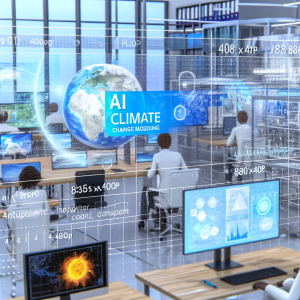-
- Transforming Our Future: AI’s Role in Climate Change Modeling for Environmental Conservation
- The Importance of AI in Climate Change Modeling
- Configuration Steps for Implementing AI in Climate Change Modeling
- Step 1: Define Objectives
- Step 2: Data Collection
- Step 3: Data Preprocessing
- Step 4: Model Selection
- Step 5: Training the Model
- Step 6: Model Evaluation
- Step 7: Deployment and Monitoring
- Practical Examples of AI in Climate Change Modeling
- Example 1: Google’s Environmental Insights Explorer
- Example 2: IBM’s Green Horizons Project
- Best Practices for AI-Driven Climate Change Modeling
- Case Studies and Statistics
- Conclusion
Transforming Our Future: AI’s Role in Climate Change Modeling for Environmental Conservation
As the world grapples with the escalating impacts of climate change, the integration of artificial intelligence (AI) into climate change modeling has emerged as a pivotal strategy for environmental conservation. AI technologies can analyze vast datasets, identify patterns, and predict future climate scenarios with unprecedented accuracy. This guide explores the transformative role of AI in climate change modeling, providing actionable steps, practical examples, and best practices for leveraging AI in environmental conservation efforts.
The Importance of AI in Climate Change Modeling
Climate change poses significant threats to ecosystems, biodiversity, and human livelihoods. Traditional climate models often struggle with the complexity and scale of environmental data. AI offers a solution by enhancing predictive capabilities and enabling more effective decision-making. By harnessing machine learning algorithms and data analytics, stakeholders can develop more accurate models that inform conservation strategies and policy-making.
Configuration Steps for Implementing AI in Climate Change Modeling
To effectively utilize AI in climate change modeling, follow these configuration steps:
Step 1: Define Objectives
- Identify specific climate-related questions or challenges you aim to address.
- Determine the scope of your modeling efforts, including geographic and temporal dimensions.
Step 2: Data Collection
- Gather relevant datasets, including historical climate data, satellite imagery, and ecological information.
- Utilize open data sources such as NASA, NOAA, and the European Space Agency.
Step 3: Data Preprocessing
- Clean and preprocess the data to remove inconsistencies and fill in missing values.
- Normalize data formats to ensure compatibility across different datasets.
Step 4: Model Selection
- Choose appropriate AI models based on your objectives, such as regression models, neural networks, or decision trees.
- Consider using frameworks like TensorFlow or PyTorch for model development.
Step 5: Training the Model
- Split your dataset into training and testing subsets to evaluate model performance.
- Use the following code snippet to train a simple regression model:
import pandas as pd
from sklearn.model_selection import train_test_split
from sklearn.linear_model import LinearRegression
# Load dataset
data = pd.read_csv('climate_data.csv')
X = data[['feature1', 'feature2']]
y = data['target']
# Split data
X_train, X_test, y_train, y_test = train_test_split(X, y, test_size=0.2)
# Train model
model = LinearRegression()
model.fit(X_train, y_train)Step 6: Model Evaluation
- Assess model accuracy using metrics such as Mean Absolute Error (MAE) or R-squared.
- Iterate on model design based on evaluation results to improve performance.
Step 7: Deployment and Monitoring
- Deploy the model in a production environment for real-time predictions.
- Continuously monitor model performance and update it with new data as it becomes available.
Practical Examples of AI in Climate Change Modeling
Several organizations have successfully implemented AI in their climate change modeling efforts:
Example 1: Google’s Environmental Insights Explorer
Google has developed the Environmental Insights Explorer, which uses AI to analyze urban carbon emissions and energy consumption. This tool helps cities make informed decisions about sustainability initiatives.
Example 2: IBM’s Green Horizons Project
IBM’s Green Horizons project employs AI to predict air quality and weather patterns. By analyzing data from various sources, it provides actionable insights for urban planners and policymakers.
Best Practices for AI-Driven Climate Change Modeling
To enhance the effectiveness of AI in climate change modeling, consider the following best practices:
- Collaborate with interdisciplinary teams, including climate scientists, data analysts, and software engineers.
- Ensure transparency in model development to facilitate trust and understanding among stakeholders.
- Regularly update models with new data to maintain accuracy and relevance.
- Utilize cloud computing resources for scalable data processing and model training.
Case Studies and Statistics
Research indicates that AI can significantly improve climate modeling accuracy. A study published in the journal Nature found that AI-enhanced models outperformed traditional models by up to 30% in predicting extreme weather events. Additionally, the use of AI in climate modeling has been linked to a 20% increase in the efficiency of resource allocation for conservation projects.
Conclusion
The integration of AI into climate change modeling represents a transformative opportunity for environmental conservation. By following the outlined configuration steps, leveraging practical examples, and adhering to best practices, stakeholders can enhance their modeling efforts and contribute to more effective climate action. As we continue to face the challenges posed by climate change, the role of AI will be crucial in shaping a sustainable future.
